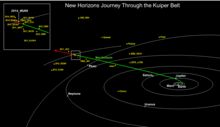2014 OS393
| 25.8[9] | |
| 10.1[1] 10.111[4] | |
2014 OS393, unofficially designated e31007AI, e3 and PT2, is a
Discovery and designation

2014 OS393 was discovered by the
Orbit and classification
2014 OS393 is a
The body's
Binary
After the New Horizons probe completed its flyby of Arrokoth, the probe began observations of other nearby surrounding Kuiper belt objects, including 2014 OS393. Observations of 2014 OS393's brightness variations at high phase angles allowed the New Horizons probe to make a rough determination of its rotation period as well as its shape. As New Horizons observed 2014 OS393 at phase angles near 90°, it displayed large variations in brightness, indicating that its shape is either extremely elongated or 2014 OS393 could be a binary system of two separated components. 2014 OS393 appeared to be possibly a separated binary in a few resolved New Horizons images, but in 2020 this remained inconclusive.[16]
Later work by
Exploration

After the New Horizons probe completed its flyby of
On 28 August 2015, the New Horizons team announced the selection of 2014 MU69 (later named 486958 Arrokoth) as the next flyby target, eliminating the other possible targets — 2014 OS393, 2014 PN70, and 2014 MT69.[3][18][19]
The spacecraft passed 2014 OS393 in January 2019, at a distance of less than 0.1 AU (15 million km, 9.3 million miles). This makes 2014 OS393 the second closest KBO observed by New Horizons, after Arrokoth.[20]
Numbering and naming
This minor planet has not been numbered by the Minor Planet Center and remains unnamed.[1]
See also
- 2011 JY31, another tight binary KBO observed by New Horizons
- List of New Horizons topics
References
- ^ a b c d e f g "2014 OS393". Minor Planet Center. Retrieved 7 September 2021.
- ^ Planetary Society. Archivedfrom the original on 15 October 2014.
- ^ a b c d e f Zangari, Amanda (28 March 2015). "Postcards from Pluto". Tumblr.
- ^ a b c d e f "JPL Small-Body Database Browser: (2014 OS393)" (2014-10-24 last obs.). Jet Propulsion Laboratory. Retrieved 7 September 2021.
- ^ a b c d Johnston, Wm. Robert (18 August 2020). "List of Known Trans-Neptunian Objects". Johnston's Archive. Retrieved 7 September 2021.
- ^ S2CID 247088149.
- ^ a b Dickinson, David (8 October 2021). "New Horizons Discovers Kuiper Belt "Twins"". Sky & Telescope. Retrieved 13 November 2021.
- ^ Buie, Marc (15 October 2014). "New Horizons HST KBO Search Results: Status Report" (PDF). Space Telescope Science Institute. p. 23. Archived from the original(PDF) on 27 July 2015. Retrieved 6 June 2015.
- ^ S2CID 119192900.
- ^ "LCDB Data for (2014+OS393)". Asteroid Lightcurve Database (LCDB). Retrieved 7 September 2021.
- Bibcode:2015EPSC...10..417S.
- ^ "Hubble to Proceed with Full Search for New Horizons Targets". HubbleSite news release. Space Telescope Science Institute. 1 July 2014.
- ^ Schmidt, Klaus (2 July 2014). "Hubble to Proceed with Full Search for New Horizons Targets". International Space Fellowship.
- ^ "NASA's Hubble Telescope Finds Potential Kuiper Belt Targets for New Horizons Pluto Mission". HubbleSite. 15 October 2014.
- ^ Wall, Mike (15 October 2014). "Hubble Telescope Spots Post-Pluto Targets for New Horizons Probe". Space.com. Archived from the original on 15 October 2014.
- ^ Porter, S. B.; Verbiscer, A. J.; Weaver, H. A.; Spencer, J. R.; Kavelaars, J. J.; Singer, K. N.; Parker, J. W.; Stern, S. A. (2020). Shapes of TNOs from New Horizons Lightcurves (PDF). 51st Lunar and Planetary Science Conference. Lunar and Planetary Institute. 1645. Retrieved 28 February 2020.
- Bibcode:2021DPS....5330707W. 307.07.
- ^ Powell, Corey S. (29 March 2015). "Alan Stern on Pluto's Wonders, New Horizons' Lost Twin, and That Whole "Dwarf Planet" Thing". Discover. Archived from the original on 16 November 2019. Retrieved 8 May 2015.
- ^ Cofield, Calla (28 August 2015). "Beyond Pluto: 2nd Target Chosen for New Horizons Probe". Space.com.
- S2CID 255074224.
External links
- List of Transneptunian Objects, Minor Planet Center
- 2014 OS393 at the JPL Small-Body Database

